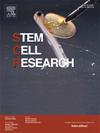Generation of an integration-free induced pluripotent stem cell line, MURAi006-A, from a hemoglobin E/β-thalassemia patient harboring the βE/β0 (Codon 17, A > T) compound heterozygous mutation
IF 0.8
4区 医学
Q4 BIOTECHNOLOGY & APPLIED MICROBIOLOGY
引用次数: 0
Abstract
The HBB gene encodes the β-globin protein, one of the two main components of adult hemoglobin A (HbA) responsible for oxygen transport. β-thalassemia is a genetic disorder caused by mutations affecting β-globin chain synthesis, leading to reduced or absent β-globin production, impaired erythropoiesis, and generally results in anemia. In this study, the human-induced pluripotent stem cell line (hiPSC) MURAi006-A was generated from male fetal skin fibroblasts carrying both a β⁰-thalassemia mutation at codon 17 (A > T) and a codon 26 (G > A) HbE mutation using non-integrative reprogramming episomes.
从携带βE/β0(密码子17,a > T)复合杂合突变的血红蛋白E/β-地中海贫血患者中获得无整合诱导多能干细胞系MURAi006-A
HBB 基因编码 β-球蛋白,它是成人血红蛋白 A(HbA)的两种主要成分之一,负责氧的运输。β-地中海贫血症是一种遗传性疾病,由影响β-球蛋白链合成的突变引起,导致β-球蛋白生成减少或缺失,红细胞生成障碍,一般会导致贫血。在这项研究中,利用非整合重编程外显子,从携带β⁰地中海贫血基因突变第17密码子(A >T)和第26密码子(G >A)HbE基因突变的雄性胎儿皮肤成纤维细胞中生成了人类诱导多能干细胞系(hiPSC)MURAi006-A。
本文章由计算机程序翻译,如有差异,请以英文原文为准。
求助全文
约1分钟内获得全文
求助全文
来源期刊

Stem cell research
生物-生物工程与应用微生物
CiteScore
2.20
自引率
8.30%
发文量
338
审稿时长
55 days
期刊介绍:
Stem Cell Research is dedicated to publishing high-quality manuscripts focusing on the biology and applications of stem cell research. Submissions to Stem Cell Research, may cover all aspects of stem cells, including embryonic stem cells, tissue-specific stem cells, cancer stem cells, developmental studies, stem cell genomes, and translational research. Stem Cell Research publishes 6 issues a year.
 求助内容:
求助内容: 应助结果提醒方式:
应助结果提醒方式:


